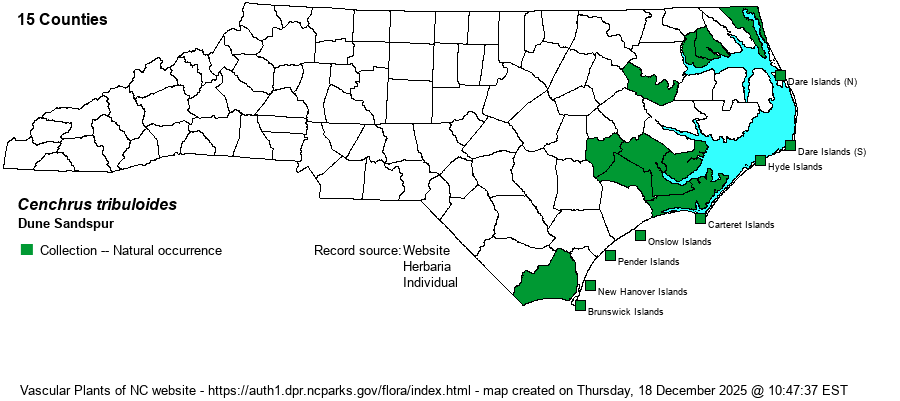| Author | L. | |
| Distribution | Outer Coastal Plain and Outer Banks/barrier islands only.
Southeastern NY to FL and TX; tropical America. | |
| Abundance | Frequent on the Outer Banks and other coastal islands. Uncommon to infrequent farther inland on the mainland. The website editors suggest a State Rank of S4 owing to its generally commonness on coastal islands. | |
| Habitat | Maritime sand dunes, maritime sand flats, maritime dry grasslands; inland sand ridges, xeric woodlands. Mostly in somewhat natural sandy habitats. | |
| Phenology | Flowering and fruiting August-October. | |
| Identification | Folks visiting our ocean and sound beaches know well this painful plant. It has larger burs than our other sandspurs -- 9-16 mm across (excluding the spines) versus 5-12 mm across in other species. | |
| Taxonomic Comments | None
Sandspurs are notorious for their extremely strong and sharp spines which catch on clothing, fur, and skin alike. The spines actually are flattened and extremely hardened bristles borne at the base of each spikelet. There also is a second set of bristles just outside the spines and not hardened. Care must be taken with a dissecting scope to reach accurate identification. NOTE: Some sites use "sandspur" and some use "sandbur" for the group common name for Cenchrus. In the Carolinas, at least, "sandspur" is much the more often used -- as do Weakley (2018) and RAB (1968) -- and thus the website editors are using that group common name. | |
| Other Common Name(s) | Sand-dune Sandspur | |
| State Rank | S3 [S4] | |
| Global Rank | G5 | |
| State Status | | |
| US Status | | |
| USACE-agcp | FACU link |
| USACE-emp | UPL link |

